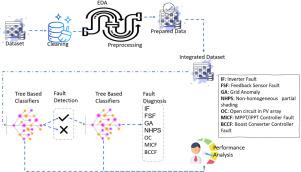Explainable artificial intelligence of tree-based algorithms for fault detection and diagnosis in grid-connected photovoltaic systems
IF 7.5
2区 计算机科学
Q1 AUTOMATION & CONTROL SYSTEMS
Engineering Applications of Artificial Intelligence
Pub Date : 2024-10-28
DOI:10.1016/j.engappai.2024.109503
引用次数: 0
Abstract
A grid-connected photovoltaic system integrates solar panels with the utility grid through a power inverter unit, allowing them to operate in parallel with the grid. Commonly known as grid-tied or on-grid solar systems, these configurations enable panels to feed electrical energy back into the grid, offering simplicity, low operating and maintenance costs, and reduced electricity bills. Despite these advantages, this environmentally friendly energy solution is still susceptible to downtimes and faults. This study utilizes advanced machine learning tree-based algorithms for fault detection and diagnosis in such systems with the goal of maintaining reliability, improving performance, and ensuring optimal energy generation. Specifically, the research investigates the effectiveness of Extra Trees as a fault detection and diagnosis algorithm through an efficient two-phase framework that consists of a binary fault detection phase followed by a multi-class fault diagnosis phase, achieving respective accuracies of 99.5% and 98.7%. In addition, the study underscores the importance of oversampling in improving results, particularly for imbalanced datasets. Moreover, explainable artificial intelligence is employed to enhance transparency in the model’s output and sensitivity to specific features in a given order. Remarkably, the findings align directly with results obtained from techniques such as feature importance averaging and incremental feature accuracy tracking. The research unveils a highly scalable, lightweight, and simple framework for fault detection and diagnosis in grid-connected photovoltaic systems.

用于并网光伏系统故障检测和诊断的树型算法的可解释人工智能
并网光伏系统通过电力逆变器装置将太阳能电池板与公用电网整合在一起,使其能够与电网并网运行。这些配置通常被称为并网型或并网型太阳能系统,可使太阳能电池板将电能反馈给电网,从而提供简便性、低运行和维护成本,并减少电费支出。尽管有这些优点,但这种环保能源解决方案仍然容易出现停机和故障。本研究利用先进的基于机器学习树的算法对此类系统进行故障检测和诊断,目的是保持可靠性、提高性能并确保最佳发电效果。具体来说,该研究通过一个高效的两阶段框架(包括二进制故障检测阶段和多类故障诊断阶段),研究了 Extra Trees 作为故障检测和诊断算法的有效性,其准确率分别达到 99.5% 和 98.7%。此外,该研究还强调了超采样对改善结果的重要性,尤其是对不平衡数据集而言。此外,还采用了可解释人工智能,以提高模型输出的透明度和对特定顺序的特定特征的敏感性。值得注意的是,研究结果与特征重要性平均法和增量特征准确性跟踪等技术得出的结果直接吻合。这项研究为并网光伏系统的故障检测和诊断揭开了一个高度可扩展、轻量级和简单的框架。
本文章由计算机程序翻译,如有差异,请以英文原文为准。
求助全文
约1分钟内获得全文
求助全文
来源期刊

Engineering Applications of Artificial Intelligence
工程技术-工程:电子与电气
CiteScore
9.60
自引率
10.00%
发文量
505
审稿时长
68 days
期刊介绍:
Artificial Intelligence (AI) is pivotal in driving the fourth industrial revolution, witnessing remarkable advancements across various machine learning methodologies. AI techniques have become indispensable tools for practicing engineers, enabling them to tackle previously insurmountable challenges. Engineering Applications of Artificial Intelligence serves as a global platform for the swift dissemination of research elucidating the practical application of AI methods across all engineering disciplines. Submitted papers are expected to present novel aspects of AI utilized in real-world engineering applications, validated using publicly available datasets to ensure the replicability of research outcomes. Join us in exploring the transformative potential of AI in engineering.
 求助内容:
求助内容: 应助结果提醒方式:
应助结果提醒方式:


